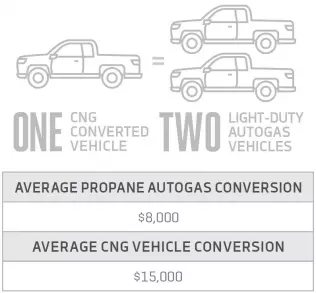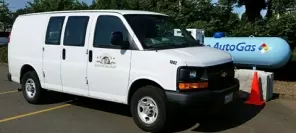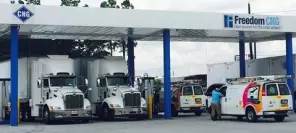- Main page
- Search
- Up to date
- Products
- Technology
- Vehicles
- Video
- Conversion Payback Simulator
Port Injection - Conversion Payback Simulator
Direct Injection - Conversion Payback Simulator
Diesel - Newsletter
LPG versus CNG the American way
 loading results...
loading results...As we wrote before, 70% of American autogas comes from shale natural gas (more specifically, from the process of its purification – methane deposits contain certain small amounts of LPG). This means you cannot simply ignore CNG, because to obtain autogas you have to extract and process even more natural gas. But that's the nature of propane and buthane – they can be separated from natural gas or crude oil, but nowhere in the world can they be found on their own. But still this doesn't mean the LPG sector's associations and companies (like Propane) cannot work to convince drivers to choose autogas over methane (not to mention conventional fuels). What arguments do they use to achieve their goal?
Less expensive refueling stations
For the money required to erect a single CNG station as many as 10 LPG retail outlets can be built! Talking numbers, an autogas distribution point costs 45-175 thousand dollars, while for CNG the figures are between 400 thousand and 1,7 million. But that's not all – as Propane argues, an LPG station can be even cheaper or actually free for the fleet operator if that operator decides to sign a long-term fuel supply contract. Given autogas is supplied regularly and in sufficient amounts, the supplier can in return co-fund or entirely fund the station. On top of that, an autogas outlet is simpler and less expensive to operate than its CNG equivalent (e. g. it consumes less energy).
More affordable conversions
For the price of converting one vehicle to run on CNG two comparable ones can be converted to LPG. Methane fuel systems are more expensive, much because of the tanks used to store fuel in – according to Propane, an autogas system costs 8000 dollars to fit, while a CNG one costs 15000. Obviously enough, cheaper conversions break even sooner and save more over time, which is of particular importance to thrifty fleet managers. And gaseous fuels are addressed mainly to them – individual conversions of passenger cars are still rare, with pick-ups, vans, trucks and buses most commonly adapted.
Nationwide availability
With 3000 stations across the US, nationwide autogas availability is something of an overstatement (in Germany or Poland, countries so much smaller than the USA, there are approx. 5000-6000 LPG stations), but nonetheless the fuel can be purchased in each and every state and new retail points (including public ones) open much more often than new CNG stations. Besides, examples of numerous countries (Poland being perhaps the most obvious) show that LPG infrastructure tends to grow much faster than its CNG equivalent. Will it be the same for the US? Possibly, but it's too early to tell.
So much for differences, but there are also similarities, since – unlike petrol – CNG actually shares some features with LPG:
- both are more environmentally-friendly than conventional, oil-derived fuels;
- both provide more value for each dollar spent, because they're simply more affordable than petrol and diesel;
- LPG and CNG are produced locally, which is of considerable importance to US buyers.
Stay tuned for the last installment – advantages of autogas versus diesel!









